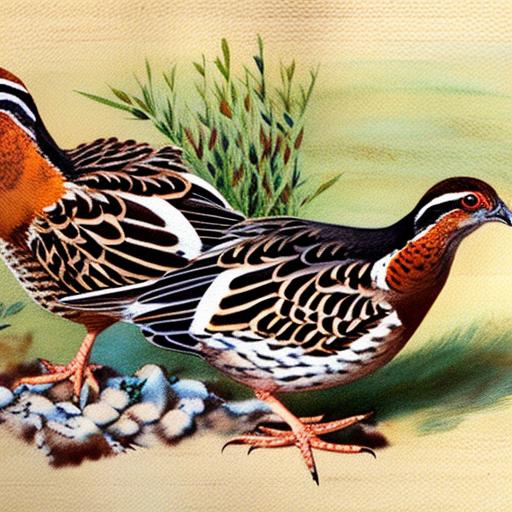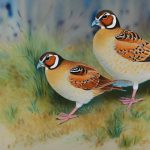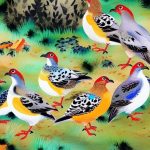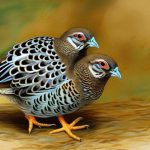The bobwhite quail, also known as the northern bobwhite, is a small ground-dwelling bird native to North America. It is a popular game bird and is often sought after by hunters for its delicious meat and challenging hunting experience. Bobwhite quail are known for their distinctive “bob-white” call, which is often heard in the early morning and late evening. These birds are typically found in grasslands, open woodlands, and agricultural fields, where they forage for seeds, insects, and small fruits. They are social birds and are often found in coveys, which are small groups of birds that forage and roost together.
Bobwhite quail are known for their distinctive appearance, with mottled brown and white feathers that provide excellent camouflage in their natural habitat. They have a plump body, short tail, and a distinctive crest on their head. These birds are known for their quick and agile movements, which make them difficult to spot and even more challenging to hunt. Bobwhite quail are also known for their strong flight capabilities, which they use to escape predators and travel between foraging areas. Overall, the bobwhite quail is a fascinating and beautiful bird that plays an important role in the ecosystem and provides valuable recreational opportunities for hunters.
The bobwhite quail is a fascinating and important species that requires specific habitat conditions to thrive. Understanding the unique needs of these birds is essential for creating an ideal habitat that supports their population and provides opportunities for hunting and wildlife viewing. By learning about the behavior, diet, and habitat preferences of bobwhite quail, landowners and conservationists can make informed decisions about habitat management and conservation efforts to support these iconic birds. With the right knowledge and resources, it is possible to create and maintain high-quality bobwhite quail habitat that benefits both the birds and the people who enjoy them.
Key Takeaways
- Bobwhite quail are ground-dwelling birds native to North America, known for their distinctive “bob-white” call.
- Creating the ideal habitat for bobwhite quail involves providing open grasslands, shrubby areas, and water sources.
- Raising bobwhite quail chicks requires a brooder with proper heating, bedding, and access to game bird starter feed.
- Breeding bobwhite quail involves providing nesting areas and ensuring proper male to female ratios for successful mating.
- Caring for adult bobwhite quail includes providing a balanced diet, protection from predators, and regular health checks.
- Common health issues for bobwhite quail include respiratory infections and parasites, which can be addressed with proper hygiene and veterinary care.
- Harvesting and utilizing bobwhite quail involves ethical hunting practices and utilizing the meat for culinary purposes.
Creating the Ideal Habitat for Bobwhite Quail
Creating the ideal habitat for bobwhite quail requires careful consideration of their specific habitat needs and preferences. Bobwhite quail thrive in open grasslands, agricultural fields, and early successional habitats with a mix of grasses, forbs, and shrubs. These birds rely on dense ground cover for nesting and brood-rearing, as well as open areas for foraging and movement. Landowners can create ideal bobwhite quail habitat by implementing habitat management practices such as prescribed burning, grazing management, and native grassland restoration. These practices help maintain diverse vegetation structure and composition that supports the needs of bobwhite quail throughout the year.
Prescribed burning is a valuable tool for maintaining open grasslands and early successional habitats that are essential for bobwhite quail. By using controlled burns to remove accumulated thatch and woody vegetation, landowners can promote the growth of native grasses and forbs that provide food and cover for quail. Grazing management is another important practice for creating ideal bobwhite quail habitat, as it helps maintain diverse vegetation structure and prevents the encroachment of woody plants into open grasslands. Additionally, restoring native grasslands through planting native grasses and forbs can provide high-quality habitat for bobwhite quail and other grassland wildlife. By implementing these habitat management practices, landowners can create and maintain ideal habitat for bobwhite quail that supports healthy populations and provides valuable recreational opportunities.
Raising Bobwhite Quail Chicks
Raising bobwhite quail chicks can be a rewarding experience for landowners and conservationists who are interested in supporting these iconic birds. Bobwhite quail chicks are precocial, which means they are born with their eyes open, fully feathered, and able to move around shortly after hatching. This unique trait allows them to quickly begin foraging for food and learning essential survival skills from their parents. When raising bobwhite quail chicks in captivity, it is important to provide them with a suitable brooder environment that meets their specific needs for warmth, food, water, and space to move around.
A brooder environment for bobwhite quail chicks should include a heat source such as a heat lamp or brooder plate to maintain a consistent temperature of around 95-100 degrees Fahrenheit during the first week of life, gradually decreasing to room temperature by 6 weeks of age. Chicks should have access to a high-quality game bird starter feed that provides essential nutrients for growth and development. Additionally, clean water should be provided at all times to ensure proper hydration. It is important to monitor the chicks closely during the first few weeks of life to ensure they are healthy and thriving. By providing a suitable brooder environment and proper care, landowners can successfully raise bobwhite quail chicks and contribute to the conservation of this iconic species.
Breeding Bobwhite Quail
Breeding bobwhite quail is an important aspect of managing populations and supporting healthy quail habitat. Bobwhite quail are known for their strong breeding instincts and can produce multiple clutches of eggs throughout the breeding season under favorable conditions. Breeding typically occurs in the spring and early summer when food resources are abundant, temperatures are warm, and daylight hours are long. During this time, male bobwhite quail use their distinctive calls to attract females and establish territories where they can court potential mates.
To support successful breeding of bobwhite quail, landowners can implement habitat management practices that provide suitable nesting cover and food resources for breeding pairs. Dense grass cover, shrubs, and forbs provide essential nesting habitat for female quail, while open areas with abundant seeds and insects support the nutritional needs of breeding pairs. By maintaining diverse vegetation structure and composition through prescribed burning, grazing management, and native grassland restoration, landowners can create ideal breeding habitat for bobwhite quail. Additionally, providing supplemental food sources such as game bird feeders can help support breeding pairs during periods of limited natural food availability. By supporting successful breeding of bobwhite quail, landowners can contribute to healthy populations and sustainable hunting opportunities.
Caring for Adult Bobwhite Quail
Caring for adult bobwhite quail involves providing suitable habitat conditions that support their nutritional needs, reproductive success, and overall well-being. Adult bobwhite quail require diverse vegetation structure with a mix of grasses, forbs, shrubs, and open areas for nesting, brood-rearing, and foraging. Landowners can support adult bobwhite quail by implementing habitat management practices such as prescribed burning, grazing management, and native grassland restoration that maintain high-quality habitat throughout the year.
In addition to habitat management, providing supplemental food sources such as game bird feeders can help support adult bobwhite quail during periods of limited natural food availability. These feeders can be filled with high-quality game bird feed that provides essential nutrients for adult quail throughout the year. Clean water sources should also be provided to ensure proper hydration for adult birds. By providing suitable habitat conditions and supplemental food sources, landowners can support healthy populations of adult bobwhite quail on their property.
Common Health Issues and How to Address Them
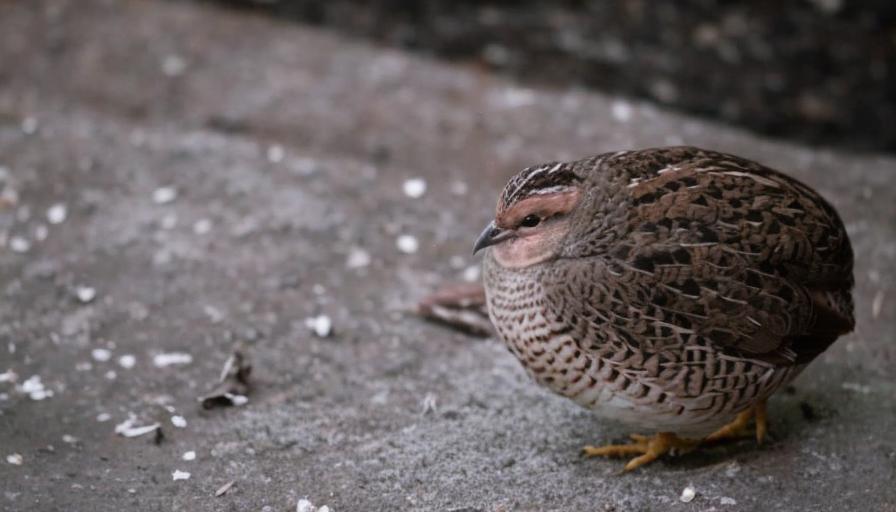
Bobwhite quail are generally hardy birds but can be susceptible to certain health issues that may impact their overall well-being. Common health issues in bobwhite quail include respiratory infections, parasites, injuries from predators or other birds, and nutritional deficiencies. Respiratory infections can be caused by poor ventilation or exposure to drafts in the brooder environment or housing facilities. Parasites such as mites or lice can also impact the health of bobwhite quail if left untreated.
To address common health issues in bobwhite quail, it is important to provide a clean and well-ventilated environment that minimizes exposure to drafts and pathogens. Regular cleaning of housing facilities and brooder environments can help prevent respiratory infections and parasite infestations. Additionally, providing a high-quality diet that meets the nutritional needs of bobwhite quail can help prevent nutritional deficiencies that may impact their health. If health issues arise, it is important to consult with a veterinarian or avian specialist who can provide guidance on treatment options and preventive measures.
Harvesting and Utilizing Bobwhite Quail
Harvesting bobwhite quail is a popular recreational activity that provides opportunities for hunters to enjoy the outdoors while contributing to conservation efforts through sustainable harvest practices. When harvesting bobwhite quail, it is important to follow local regulations and guidelines to ensure ethical and sustainable hunting practices. Hunters should obtain the necessary permits and licenses required by state wildlife agencies before pursuing bobwhite quail.
After harvesting bobwhite quail, it is important to utilize the meat in a respectful manner that honors the bird’s life and contributes to sustainable harvest practices. Bobwhite quail meat is known for its delicious flavor and versatility in cooking. It can be prepared in various ways such as grilling, roasting, or frying to create delicious meals that showcase the natural flavors of the meat. By utilizing harvested bobwhite quail meat in a responsible manner, hunters can appreciate the value of sustainable harvest practices while enjoying the rewards of their hunting experience.
In conclusion, understanding the unique needs of bobwhite quail is essential for creating ideal habitat conditions that support healthy populations of these iconic birds. By implementing habitat management practices such as prescribed burning, grazing management, and native grassland restoration, landowners can create high-quality habitat that benefits both bobwhite quail and other grassland wildlife. Raising bobwhite quail chicks in captivity requires providing a suitable brooder environment with proper warmth, food, water, and space to move around. Breeding bobwhite quail involves supporting successful breeding pairs through habitat management practices that provide suitable nesting cover and food resources. Caring for adult bobwhite quail involves providing diverse vegetation structure with supplemental food sources such as game bird feeders to support their nutritional needs throughout the year. Addressing common health issues in bobwhite quail requires providing a clean environment with proper ventilation and nutrition while consulting with a veterinarian or avian specialist if health issues arise. Harvesting bobwhite quail provides opportunities for hunters to enjoy sustainable harvest practices while utilizing the meat in a respectful manner that honors the bird’s life. Overall, creating ideal habitat conditions, raising chicks in captivity, supporting breeding pairs, caring for adult birds, addressing health issues, and harvesting bobwhite quail are all important aspects of managing populations and supporting healthy populations of these iconic birds.
If you’re interested in raising and breeding bobwhite quail, you might also want to learn about the breeding habits of other poultry. Check out this informative article on when guinea fowl lay eggs to gain insights into the breeding patterns of another fascinating bird species. Understanding the reproductive behaviors of different poultry can provide valuable knowledge for anyone involved in aviculture.
FAQs
What are the basic requirements for raising and breeding bobwhite quail?
To raise and breed bobwhite quail, you will need a suitable habitat with proper shelter, food, and water. Additionally, you will need to provide nesting areas and a safe environment for the quail to breed and raise their young.
What type of habitat is suitable for raising and breeding bobwhite quail?
Bobwhite quail require a habitat with a mix of open grasslands, shrubby areas, and woodlands. They prefer areas with dense ground cover for nesting and protection from predators.
What do bobwhite quail eat and drink?
Bobwhite quail are omnivorous and eat a diet that includes seeds, grains, insects, and small invertebrates. They also require access to clean water for drinking.
How do bobwhite quail breed and raise their young?
Bobwhite quail typically form monogamous pairs during the breeding season. The female will create a shallow nest on the ground and lay a clutch of eggs. Both parents will take turns incubating the eggs and caring for the chicks once they hatch.
What are some common predators of bobwhite quail?
Common predators of bobwhite quail include snakes, raccoons, foxes, and birds of prey. It is important to provide adequate protection and shelter to minimize predation.
Are there any specific health considerations for raising and breeding bobwhite quail?
It is important to monitor the health of the quail and provide a clean and sanitary environment to prevent the spread of diseases. Additionally, proper nutrition and access to clean water are essential for maintaining the health of the quail.
Meet Walter, the feathered-friend fanatic of Florida! Nestled in the sunshine state, Walter struts through life with his feathered companions, clucking his way to happiness. With a coop that’s fancier than a five-star hotel, he’s the Don Juan of the chicken world. When he’s not teaching his hens to do the cha-cha, you’ll find him in a heated debate with his prized rooster, Sir Clucks-a-Lot. Walter’s poultry passion is no yolk; he’s the sunny-side-up guy you never knew you needed in your flock of friends!

